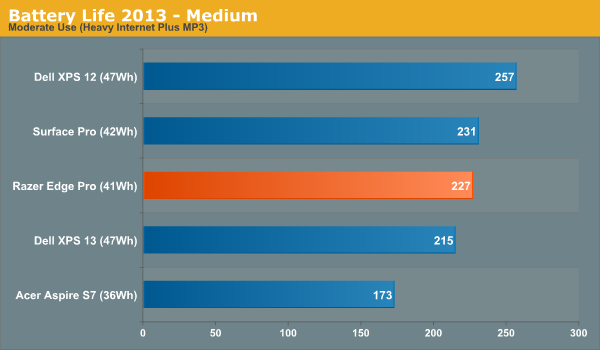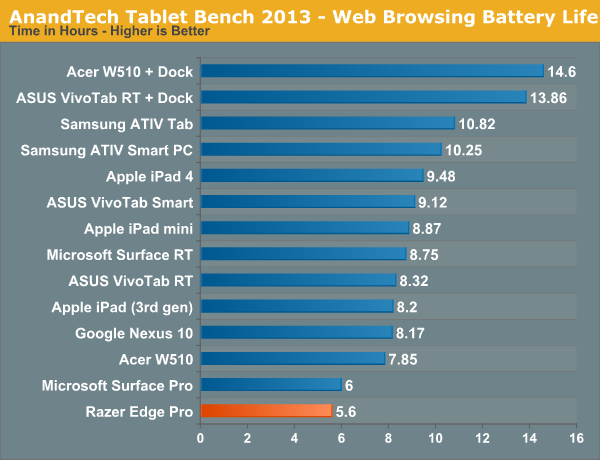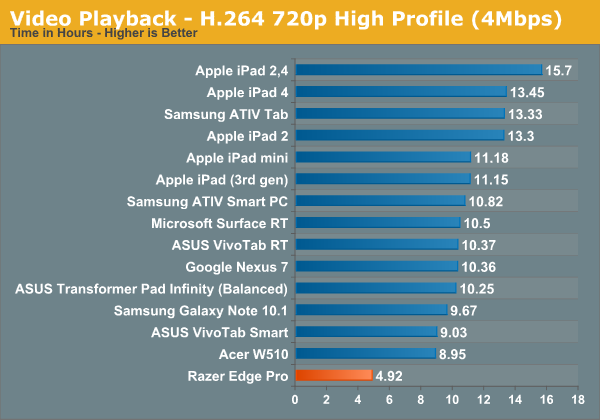The Razer Edge Review
by Vivek Gowri on March 28, 2013 11:00 AM EST- Posted in
- Tablets
- Mobile
- Razer
- Razer Edge
Battery Life and Mobile Gaming
This is the section that probably will garner the most scrutiny. The Edge comes with a 41.44Wh battery, and in normal usage situations, it does about as well as one could expect from an Ivy Bridge-based tablet. Surface Pro comes with a similarly sized battery, and we saw pretty similar runtime from the two tablets (Surface Pro, on average, had about 15-20 minutes more life in any given test). Considering that IVB ultrabooks don’t fare too much better (or, in some cases, significantly worse – looking at you Acer) I guess it’s hard to complain here; until we see Haswell and its significant idle power reduction later this year, ARM and Clovertrail tablets are going to slaughter IVB tablets in this category.




There’s an additional wrinkle with the Edge – the mobile gaming aspect. I broke down the typical gaming power draw in the introduction, and it’s worth bringing back up: pair a 17W CPU and a 20W GPU, consider that almost no reasonable workload will peg both at the same time, toss in loads for the display, SSD, RAM, WiFi, chipset, and all the other auxiliary components, and a 40W total system draw estimate in gaming workflows is pretty reasonable. If you’re using the Edge in the gamepad controller with the extended battery, there’s a total of 82.88Wh of battery power onboard. This sets up a pretty simple equation to estimate the gaming battery life: 82.88Wh/40W = ? hours. Do the simple division, and you’re looking at a hair over two hours, which is where Razer’s “two hours of gaming battery life” claim comes from. (I had John Wilson, Razer’s VP of System Engineering, walk me through the math here, and he confirmed that 80 divided by 40 did in fact equal two.)
Naturally, a good amount of testing was in order, so I unplugged the Edge, went to a nearby coffee shop, and played Dirt 3 until the battery died. I did this multiple times in the interest of generating as much data as possible (I love my job.) I was initially planning on using a timedemo or looping a benchmark, but I thought it would be more fun to actually game on the Edge – I also needed some real world mobile gaming experiences, so it killed two birds with one stone.
I spent most of my time in Dirt 3 and Need For Speed: The Run. The latter isn’t part of our benchmark suite and it’s not the most recent NFS title (it was a holiday 2011 release), but the Cannonball Run-esque storyline intrigued me and I’ve been meaning to play through it for some time without ever getting the chance to do so. The Edge review just gave me the excuse I needed to get into it.
The two hour estimate is pretty fair, depending on brightness levels, power plan, and graphics settings I saw anywhere between 1:45 and 2:30 in the newer games. I also fired up Quake III: Arena for curiosity’s sake, to see how much less strenuous a 12 year old game would be, and got 3:12 of playing time out of it. It’s worth noting that I wasn’t hitting network at all, either, so that’s another thing to consider.
In the “Balanced” power plan and a brightness of 200nits (55%), playing Dirt 3 with medium settings at the native 1366x768 resolution, the Edge lasted for 136 minutes (2:16) before running out of juice. That’s pretty much in line with what we expected, and lowering the brightness can help extend that. I wouldn’t recommend high or ultra settings due to the additional power draw, while the Power Saver profile throttles the GPU far too aggressively for smooth gameplay even at medium settings. The Balanced power profile and medium settings made for a nice compromise in mobile use cases.










89 Comments
View All Comments
VivekGowri - Friday, March 29, 2013 - link
All of the battery life tests (in the graphs) were done with the internal 41Wh battery, with the tablet alone - not attached to the gamepad or the docking station. 5 hours of light web-usage is for the tablet alone, no extended batteries involved.The gaming tests were the only ones done with the extended battery and gamepad controller (which I think have to be bought together for the package to make any sense). I do wish that the gamepad came with the extended battery by default, Razer is definitely charging too much for the accessories.
TrackSmart - Friday, March 29, 2013 - link
I think the review does a fine job of giving us a sense of the product. The one change I would make is to emphasize the battery issue in the Conclusions in a more concrete way:For example: "You can only expect around 1 hour of gaming time using the built-in 41 Wh battery and just over 2 hours with the gaming dock plus extra battery pack ($XXX extra). For a system that promises PC-quality gaming on the road, this may be a fatal flaw."
That's the point that really needs to be driven home. This is an impressive system, but the components available today do not have the power efficiency needed to make a truly portable system at this level of performance.
apertotes - Thursday, March 28, 2013 - link
Yeah, the second generation is going to be awesome... whatever. I will wait until that awesome product. And I guess many people will do the same. You can not pretend to sell a hardware product on the assumption that the next one is going to be great. This Razer Edge lacks in graphic power and battery life. This one. The one that is now for sale. That sucks.nerd1 - Thursday, March 28, 2013 - link
All razor so-called gaming PCs are big joke, I wonder what they are thinking. I'd rather get a clevo 11.6" with 650M on this.VivekGowri - Thursday, March 28, 2013 - link
I had that system, and I loved the hell out of it. GT 650M is overkill for the 1366x768 panel, FWIW. But the Edge is truly, completely different. It's just a different system in almost every way, there's no real comparison between the two other than on a benchmark sheet.nerd1 - Thursday, March 28, 2013 - link
So I just cannot understand why they chose a tablet form factor. W8 doesn't have many games with touch control (I hate touch control for gaming BTW) so you need keyboard and (good) mouse anyway. And it is not quite portable and very expensive.VivekGowri - Thursday, March 28, 2013 - link
when one sets out to make a gaming tablet, choosing a tablet form factor would in theory seem logical, no?kyuu - Thursday, March 28, 2013 - link
That's what the shell with the gamepad controls is for...?A5 - Thursday, March 28, 2013 - link
Just because you don't like something doesn't mean it is pointless.bountygiver - Thursday, March 28, 2013 - link
But hope some games can add touch control where appropriate. (Like civ 5)